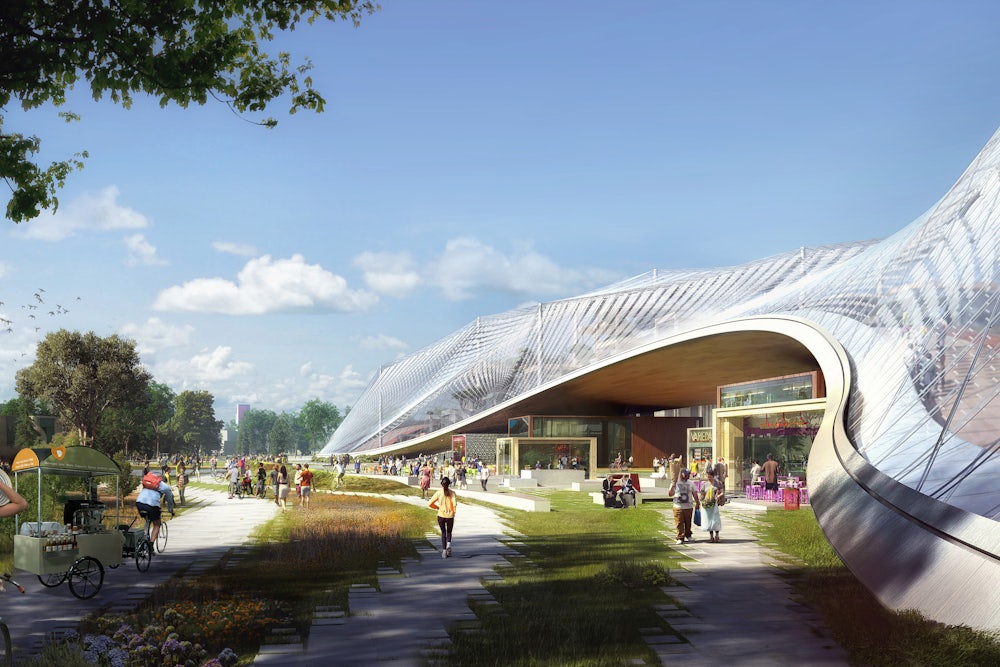Even if you haven’t heard of Bjarke Ingels, you’ve probably seen his work. The Danish designer is perhaps the world’s most successful living architect. He has designed parks, apartment buildings, four Google campuses, and a power plant hidden beneath an artificial ski slope. He has also pioneered a ubiquitous brand of bland modernism that features sleek finishes and complex, blocky forms. At only 45, Ingels is far younger than most starchitects, and he wears his boyishness proudly. He has assiduously cultivated the public persona of a millennial jet-setter, obsessed with Instagram, Scandinavian electronica, and, presumably, his hair, which juts out, like one of his spiky designs, from his forehead.
Over the years, Ingels has made much of his commitment to the environment; in TED talks, he describes his philosophy as “hedonistic sustainability” (according to Ingels, you don’t need to sacrifice comfort to live a sustainable lifestyle). And in January, on a trip to Brazil, he met with President Jair Bolsonaro to discuss crafting a master plan for sustainable tourism in the country. When critics pointed out that Bolsonaro is responsible for letting agriculture companies slash and burn swaths of the Amazon rain forest, pushing the ecosystem to its brink and displacing hundreds of indigenous people in the progress, Ingels called their concerns “an oversimplification,” “superficial clickbait,” and sheer “ignorance.” Architects, he said, have to “engage and embrace our differences if we want to dare to imagine a different future.”
Ingels is hardly the first architect to work for an autocratic leader. The Italian Giuseppe Terragni designed the Casa del Fascio for Mussolini. Albert Speer laid out neoclassical buildings for the Third Reich. Even respected modernists, such as the German Peter Behrens and the midcentury American architect Philip Johnson, tried to ingratiate themselves with the Nazis. Through their work, they gave a distinct aesthetic and cultural legitimacy to these regimes, while lining their own pockets with what was essentially blood money.

Today, it’s far more difficult to decide what makes a project unethical. We can probably agree that it’s wrong to build prototypes for Donald Trump’s border wall. But what about new rail stations for the suppressive Saudi regime? Or one of the new stadiums Qatar has commissioned for the next World Cup? There, thousands of migrant workers are toiling in inhuman conditions to build designs such as Zaha Hadid’s; according to The Guardian, hundreds have died. There are even deeper shades of gray. No one will die constructing, say, a new headquarters for the fossil fuel industry or Big Tobacco. But plenty could die from the products made and marketed from within those buildings. Should the firms Pickard Chilton and Gensler, which designed and constructed ExxonMobil’s new headquarters in 2014, have turned that contract down? Or, to give a more contemporary example, what about the architect who chooses to work with tech companies such as Google or Facebook, whose products are used to actively undermine democracy and spy on ordinary citizens? Where do we draw the line between uncomfortable and unethical?
Architects have justified their work by saying they’re “just doing business” or “if I don’t take the project, someone worse will.” Such arguments suggest that they can somehow wipe their hands clean of the consequences of their designs, be they horrifying labor conditions or gentrification. And yet, at the same time, architects like Ingels often claim that design alone can solve what are essentially political problems. I have a favorite line in The Art of Inequality: “No building … creates inequality as such. Assuming so would be to grossly overestimate architecture’s power.” The inverse is also true: No building creates equality, as such, either. But if architects believe in making the world a better, more beautiful place, it’s time for them to join the resistance.
